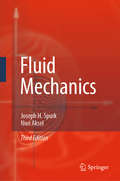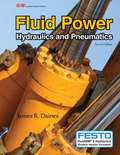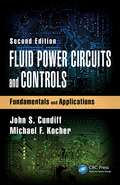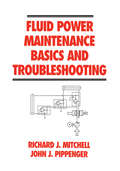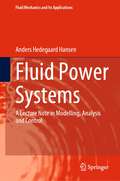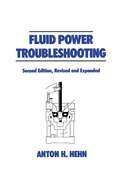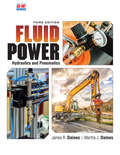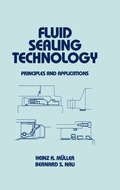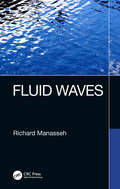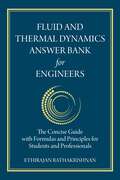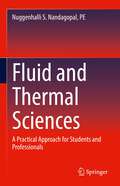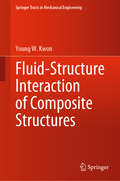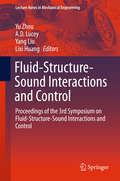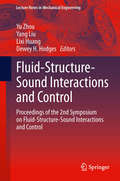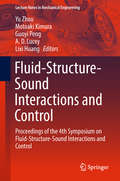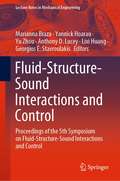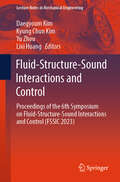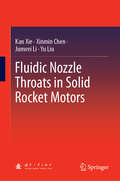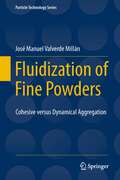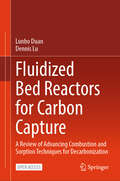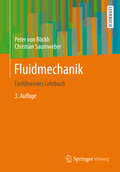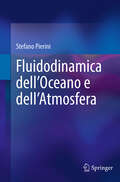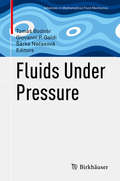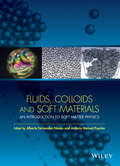- Table View
- List View
Fluid Mechanics: Problems And Solutions
by Nuri Aksel Joseph H. SpurkThis successful textbook emphasizes the unified nature of all the disciplines of Fluid Mechanics as they emerge from the general principles of continuum mechanics. The different branches of Fluid Mechanics, always originating from simplifying assumptions, are developed according to the basic rule: from the general to the specific. The first part of the book contains a concise but readable introduction into kinematics and the formulation of the laws of mechanics and thermodynamics. The second part consists of the methodical application of these principles to technology. In addition, sections about thin-film flow and flow through porous media are included.
Fluid Power (Second Edition): Hydraulics and Pneumatic
by James R. DainesFluid Power: Hydraulics and Pneumaticsis a teaching package aimed at students pursuing a technician-level career path. It teaches the fundamentals of fluid power and provides details on the design and operation of hydraulic and pneumatic components, circuits, and systems. Extensive coverage is provided for both hydraulic and pneumatic systems. This book does not contain engineering calculations that will confuse students. Instead, it applies math skills to the formulas needed by the technician-level student. Full-color illustrations throughout the text. Each chapter includes detailed Internet resources related to the chapter topics to allow further exploration. Laboratory manual contains activities correlated to the chapter topic, and chapter quizzes to measure student knowledge. Bundled with the textbook is the student version of FluidSIM Hydraulics simulation software. This popular software from Festo Didactic allows circuits to be designed and simulated on the computer. The software can be used to provide additional activities of your own design.
Fluid Power Circuits and Controls: Fundamentals and Applications, Second Edition
by John S. Cundiff Michael F. KocherFluid Power Circuits and Controls: Fundamentals and Applications, Second Edition, is designed for a first course in fluid power for undergraduate engineering students. After an introduction to the design and function of components, students apply what they’ve learned and consider how the component operating characteristics interact with the rest of the circuit. The Second Edition offers many new worked examples and additional exercises and problems in each chapter. Half of these new problems involve the basic analysis of specific elements, and the rest are design-oriented, emphasizing the analysis of system performance. The envisioned course does not require a controls course as a prerequisite; however, it does lay a foundation for understanding the extraordinary productivity and accuracy that can be achieved when control engineers and fluid power engineers work as a team on a fluid power design problem. A complete solutions manual is available for qualified adopting instructors.
Fluid Power Maintenance Basics and Troubleshooting
by Richard J. Mitchell John J. PippengerThis unique single-source reference-the first book of its kind to address systematically the problems involved in the field-offers comprehensive coverage of hydraulic system troubleshooting and encourages change in the trial-and-error methods common in rectifying problems and restoring system downtime, furnishing a new paradigm for troubleshooting
Fluid Power Systems: A Lecture Note in Modelling, Analysis and Control (Fluid Mechanics and Its Applications #129)
by Anders Hedegaard HansenThis book covers some of the fundamental topics in fluid power technology, presenting detailed derivations of formulas that form the basis of the theory. It shows the reader how to properly (i) design basic fluid power systems, (ii) construct lumped parameter models of simple fluid power systems, (iii) perform frequency analysis of fluid power components and systems, and (iv) develop controllers for fluid power systems. The book mainly focusses on mathematical modelling and analysis of fluid power components and systems i.e. practical issues such as working principles and construction of components are not covered in depth. The text is organized in four main parts: I Physics of Fluid, II Fluid Power Components, III Fluid Power Systems and IV Learning by Doing.
Fluid Power Troubleshooting, Second Edition,
by Anton HehnPresents practical methods for detecting, diagnosing and correcting fluid power problems within a system. The work details the design, maintenance, and troubleshooting of pneumatic, hydraulic and electrical systems and components. This second edition stresses: developments in understanding the complex interactions of components within a fluid power system; cartridge valve systems, proportional valve and servo-systems, and compressed air drying and filtering; noise reduction and other environmental concerns; and more.;This work should be of interest to mechanical, maintenance, manufacturing, system and machine design, hydraulic, pneumatic, industrial, chemical, electrical and electronics, lubrication, plastics processing, automotive, process control, and power system engineers; manufacturers of hydraulic and pneumatic machinery; systems maintenance personnel; and upper-level undergraduate and graduate students in these disciplines.
Fluid Power: Hydraulics And Pneumatics
by James R. Daines Martha J. DainesFluid Power: Hydraulics and Pneumatics is an introductory text targeted to students pursuing a technician-level career path. It presents the fundamentals of this subject with extensive coverage of both hydraulic and pneumatic systems. Coverage includes details on the design and operation of hydraulic and pneumatic components, circuits, and systems.
Fluid Sealing Technology: Principles and Applications
by Heinz K Muller"Assists users, developers, researchers, and manufacturers in the design, selection, development, and application of seals and sealing systems for fluids."
Fluid Waves
by Richard ManassehThe book derives the mathematical basis for the most encountered waves in science and engineering. It gives the basis to undertake calculations required for important occupations such as maritime engineering, climate science, urban noise control, and medical diagnostics. The book initiates with fluid dynamics basis with subsequent chapters covering surface gravity waves, sound waves, internal gravity waves and waves in rotating fluids, and details basic phenomena such as refraction. Thereafter, specialized application chapters include description of specific contemporary problems. All concepts are supported by narrative examples, illustrations, and case studies. Features:- Explains the basis of wave mechanics in fluid systems. Provides tools for the analysis of water waves, sound waves, internal gravity, and rotating fluid waves through different examples. Includes comprehensible mathematical derivations at the expense of fewer theoretical topics. Reviews cases describable by linear theory and cases requiring nonlinear and wave-interaction theories. Supports concepts with narrative examples, illustrations, and case studies. This book aims at Senior Undergraduates/Graduate students and Researchers in Fluid Mechanics, Applied Mathematics, Mechanical Engineering, Civil Engineering, and Physical Oceanography.
Fluid and Thermal Dynamics Answer Bank for Engineers: The Concise Guide with Formulas and Principles for Students and Professionals
by Ethirajan RathakrishnanThis book provides the essence of aerodynamics, fluid mechanics, experimental methods, gas dynamics, high enthalpy gas dynamics, helicopter aerodynamics, heat transfer, and thermodynamics, describing the underlying principles of these subjects before list
Fluid and Thermal Sciences: A Practical Approach for Students and Professionals
by Nuggenhalli S. Nandagopal, PEThis text provides a clear understanding of the fundamental principles of thermal and fluid sciences in a concise manner in a rigorous yet easy to follow language and presentation. Elucidation of the principles is further reinforced by examples and practice problems with detailed solutions. Firmly grounded in the fundamentals, the book maximizes readers’ capacity to take on new problems and challenges in the field of fluid and thermal sciences with confidence and conviction. Standing also as a ready reference and review of the essential theories and their applications in fluid and thermal sciences, the book is applicable for undergraduate mechanical and chemical engineering students, students in engineering technology programs, as well as practicing engineers preparing for the engineering license exams (FE and PE) in USA and abroad.Explains the concepts and theory with a practical approach that readers can easily absorb;Provides the just the right amount of theoretical and mathematical background needed, making it less intimidating for the reader;Covers fluid and thermal sciences in a straight-forward yet comprehensive manner facilitating a good understanding of the subject matter;Includes a wide spectrum and variety of problems along with numerous illustrative solved examples and many practice problems with solutions.
Fluid-Induced Seismicity
by Serge A. ShapiroThe characterisation of fluid transport properties of rocks is one of the most important, yet difficult, challenges of reservoir geophysics, but is essential for optimal development of hydrocarbon and geothermal reservoirs. This book provides a quantitative introduction to the underlying physics, application, interpretation, and hazard aspects of fluid-induced seismicity with a particular focus on its spatio-temporal dynamics. It presents many real data examples of microseismic monitoring of hydraulic fracturing at hydrocarbon fields and of stimulations of enhanced geothermal systems. The author also covers introductory aspects of linear elasticity and poroelasticity theory, as well as elements of seismic rock physics and mechanics of earthquakes, enabling readers to develop a comprehensive understanding of the field. Fluid-Induced Seismicity is a valuable reference for researchers and graduate students working in the fields of geophysics, geology, geomechanics and petrophysics, and a practical guide for petroleum geoscientists and engineers working in the energy industry.
Fluid-Structure Interaction of Composite Structures (Springer Tracts in Mechanical Engineering)
by Young W. KwonThis is the first book presenting dynamic responses and failure of polymer composite structures as they interact with internal and/or external fluid media. It summarizes authoritative research carried out by the author in the past decade on various aspects of Fluid-Structure Interaction (FSI) to present important effects of FSI on composite structures. The topics include impact loading on composite structures with air-back, water-back, or containing water; FSI effects on frequencies, mode shapes, and modal curvatures; cyclic loading for fatigue failure with FSI; coupling of independent composite structures by fluid media; and moving composite structures in water. Numerical techniques for FSI are also presented. Research was conducted both experimentally and numerically to complement each other. The book offers a timely, comprehensive information to fluid-structure interaction of composite structures for students, researchers or practicing engineers.
Fluid-Structure-Sound Interactions and Control
by Yang Liu Yu Zhou Lixi Huang A. D. LuceyTheseproceedings primarily focus on advances in the theory, experiments, andnumerical simulations of turbulence in the contexts of flow-induced vibrationand noise, as well as their control. Fluid-related structural vibration andnoise problems are often encountered in many engineering fields, increasinglymaking them a cause for concern. The FSSIC conference, held on 5-9 July 2015 inPerth, featured prominent keynote speakers such as John Kim, Nigel Peake, SongFu and Colin Hansen, as well as talks on a broad range of topics: turbulence,fluid-structure interaction, fluid-related noise and the control/managementaspects of these research areas, many of which are clearly interdisciplinary innature. It provided a forum for academics, scientists and engineers working inall branches of Fluid-Structure-Sound Interactions and Control (FSSIC) toexchange and share the latest developments, ideas and advances, bringing themtogether researchers from East and West to push forward the frontiers of FSSIC,ensuring that the proceedings will be of interest to a broad engineeringcommunity.
Fluid-Structure-Sound Interactions and Control
by Dewey H. Hodges Yang Liu Yu Zhou Lixi HuangWith rapid economic and industrial development in China, India and elsewhere, fluid-related structural vibration and noise problems are widely encountered in many fields, just as they are in the more developed parts of the world, causing increasingly grievous concerns. Turbulence clearly has a significant impact on many such problems. On the other hand, new opportunities are emerging with the advent of various new technologies, such as signal processing, flow visualization and diagnostics, new functional materials, sensors and actuators, etc. These have revitalized interdisciplinary research activities, and it is in this context that the 2nd symposium on fluid-structure-sound interactions and control (FSSIC) was organized. Held in Hong Kong (May 20-21, 2013) and Macau (May 22-23, 2013), the meeting brought together scientists and engineers working in all related branches from both East and West and provided them with a forum to exchange and share the latest progress, ideas and advances and to chart the frontiers of FSSIC. The Proceedings of the 2nd Symposium on Fluid-Structure-Sound Interactions and Control largely focuses on advances in the theory, experimental research and numerical simulations of turbulence in the contexts of flow-induced vibration, noise and their control. This includes several practical areas for interaction, such as the aerodynamics of road and space vehicles, marine and civil engineering, nuclear reactors and biomedical science etc. One of the particular features of these proceedings is that it integrates acoustics with the study of flow-induced vibration, which is not a common practice but is scientifically very helpful in understanding, simulating and controlling vibration. This offers a broader view of the discipline from which readers will benefit greatly. These proceedings are intended for academics, research scientists, design engineers and graduate students in engineering fluid dynamics, acoustics, fluid and aerodynamics, vibration, dynamical systems and control etc. Yu Zhou is a professor in Institute for Turbulence-Noise-Vibration Interaction and Control at Harbin Institute of Technology. Yang Liu is an associate professor at The Hong Kong Polytechnic University. Lixi Huang, associate professor, works at the University of Hong Kong. Professor Dewey H. Hodges works at the School of Aerospace Engineering, Georgia Institute of Technology.
Fluid-Structure-Sound Interactions and Control: Proceedings Of The 2nd Symposium On Fluid-structure-sound Interactions And Control (Lecture Notes In Mechanical Engineering)
by Yu Zhou Lixi Huang A. D. Lucey Motoaki Kimura Guoyi PengThis book presents the proceedings of the Symposium on Fluid-Structure-Sound Interactions and Control (FSSIC), (held in Tokyo on Aug. 21-24, 2017), which largely focused on advances in the theory, experiments on, and numerical simulation of turbulence in the contexts of flow-induced vibration, noise and their control. This includes several practical areas of application, such as the aerodynamics of road and space vehicles, marine and civil engineering, nuclear reactors and biomedical science, etc. Uniquely, these proceedings integrate acoustics with the study of flow-induced vibration, which is not a common practice but can be extremely beneficial to understanding, simulating and controlling vibration. The symposium provides a vital forum where academics, scientists and engineers working in all related branches can exchange and share their latest findings, ideas and innovations – bringing together researchers from both east and west to chart the frontiers of FSSIC.
Fluid-Structure-Sound Interactions and Control: Proceedings of the 5th Symposium on Fluid-Structure-Sound Interactions and Control (Lecture Notes in Mechanical Engineering)
by Marianna Braza Yu Zhou Lixi Huang Yannick Hoarau Georgios E. Stavroulakis Anthony D. LuceyThis book contains a thorough and unique record of recent advances in the important scientific fields fluid–structure interaction, acoustics and control of priority interest in the academic community and also in an industrial context regarding new engineering designs. It updates advances in these fields by presenting state-of-the-art developments and achievements since the previous Book published by Springer in 2018 after the 4th FSSIC Symposium. This book is unique within the related literature investigating advances in these fields because it addresses them in a complementary way and thereby enhances cross-fertilization between them, whereas other books treat these fields separately.
Fluid-Structure-Sound Interactions and Control: Proceedings of the 6th Symposium on Fluid-Structure-Sound Interactions and Control (FSSIC 2023) (Lecture Notes in Mechanical Engineering)
by Yu Zhou Lixi Huang Daegyoum Kim Kyung Chun KimThis proceedings book focuses on advances in theory, experiments and numerical simulations of fluid-structure-sound interactions related to turbulence, flow-induced vibration, noise and their control. This includes important practical areas of interaction such as vehicle aerodynamics, marine and civil engineering, nuclear reactors and biomedicine. One of the special features of this book is that it integrates new emerging fields with the study of fluid-structure-sound interactions, which is not common practice but scientifically very helpful in understanding, simulating and controlling fluid-structure-sound interaction systems. This provides a broader view of the discipline from which readers will benefit greatly.
Fluidic Nozzle Throats in Solid Rocket Motors
by Yu Liu Kan Xie Xinmin Chen Junwei LiThis book focuses on the performance and application of fluidic nozzle throats for solid rocket motors, discussing their flow details and characterization performance, as well as the influence of the particle phase on their performance. It comprehensively covers a range of fluidic nozzle throats in solid rocket motors and is richly illustrated with impressive figures and full-color photographs. It is a valuable resource for students and researchers in the fields of aeronautics, astronautics and related industries wishing to understand the fundamentals and theories of fluidic nozzle throats and engage in fluidic nozzle throat analysis and design.
Fluidization of Fine Powders
by José Manuel Valverde MillánThis book covers the rich phenomenology exhibited by fine powders when they are fluidized by a gas flow. Fine powder cohesiveness leads to poor flowability, clumping, difficulty in fluidizing, irregular avalanching behavior, etc. Despite all the inconveniences, fine powder processes pervade the chemical, pharmaceutical, agricultural and mining industries among others. The author in this book analyzes the mechanism by which interparticle adhesive forces are reduced by means of surface additives. Different techniques have been developed in the last years to assist fluidization by helping the gas flow to mobilize and break cohesive aggregates, which help to homogenize fluidization. As reviewed in this book, the use of these techniques may have a relevant impact on novel processes based on fluidized beds of fine powder and with relevant applications on leading edge technologies such as Atomic Layer Deposition on nanoparticles and CO2 capture by gas-fluidized beds of adsorbent powders. The study of fluidized beds has a marked interdisciplinary character. This book is thus intended for academic and industrial researchers in applied physics, mechanical, chemical, and environmental engineering, who are interested in the special characteristics of fine powders.
Fluidized Bed Reactors for Carbon Capture: A Review of Advancing Combustion and Sorption Techniques for Decarbonization
by Lunbo Duan Dennis LuThis open access book provides a perspective on CO2 capture technologies that employ fluidized bed rectors, (FBRs) involving pre-combustion gasification, oxy-fuel combustion, chemical looping combustion, calcium looping process, and low-temperature sorption. The state-of-the-art progress from the lab-scale FBRs to pilot-scale demonstration facilities is summarized, and the remaining challenges are discussed. Moreover, this book also discussed the future solutions to overcome existing barriers in the application of FBRs for CO2 capture and provided an outlook on potential advancements and improvements. The authors anticipate endeavors made herein can impel the commercialization of fluidized bed technologies for CO2 capture from large industrial sources.
Fluidmechanik: Einführendes Lehrbuch
by Christian Saumweber Peter Von BöckhDieses Lehrbuch liegt jetzt in der 3. Auflage vor. Es behandelt u.a. - die wichtige Berechnung des Druckverlustes bei der Strömung von Flüssigkeits-/Gasgemischen in Rohren - die kritische Strömung von Gasen und Flüssigkeits-/Gasgemischen - die Strömung kompressibler Fluide mit hoher Geschwindigkeit (Fanno-Linie) - Reibungsdruckverluste in quer angeströmten Rohrbündeln - Grundlagen der numerischen Lösungsmethoden - Strömungsmesstechnik und Fehlerrechnung - in Mathcad erstellte Beispiele, die im Internet abgerufen werden können. Die Studierenden lernen, mit Hilfe des Buches anspruchsvolle Apparate, wie z.B. Raketenbrennkammer, Verdampfer oder Kondensatoren für Wärmepumpen, selbständig auszulegen. Der Aufbau des Buches zeichnet sich durch eine praxisnahe, klar strukturierte und systematische Darstellung aus. Zahlreiche durchgerechnete Beispiele erleichtern das Verständnis. Die Zielgruppen Studierende des Maschinenbaus und der Verfahrenstechnik an Universitäten und Fachhochschulen
Fluidodinamica dell’Oceano e dell’Atmosfera
by Stefano PieriniQuesto testo esplora la Fluidodinamica dell'Oceano e dell'Atmosfera ed è concepito specificamente per corsi di laurea di primo livello (B.Sc., livello upper undergraduate). Sebbene la fluidodinamica sia ampiamente trattata in vari corsi di Ingegneria - come l’Ingegneria Meccanica, Civile, Idraulica, Navale e Aerospaziale - esiste una carenza di testi universitari che affrontino l'argomento con un approccio più aderente alla Fisica e che includano specifici aspetti riguardanti l’oceano e l’atmosfera. Questo libro nasce con l’obiettivo di colmare tale lacuna. Nella prima parte, dopo un'introduzione ai fondamenti della fluidodinamica incompressibile - evitando di soffermarsi su aspetti di interesse puramente ingegneristico - viene trattato in dettaglio un tema di grande rilevanza meteo-oceanografica: le onde di gravità, sia superficiali sia interne. La seconda parte è interamente dedicata alla fluidodinamica in sistemi di riferimento rotanti, con un focus sugli aspetti basilari della meteorologia e dell’oceanografia dinamica, nei quali la forza apparente di Coriolis gioca un ruolo cruciale. Questo testo si propone come una preziosa risorsa per studenti e ricercatori che desiderino acquisire le basi della fluidodinamica applicata a contesti oceanici e atmosferici, offrendo una prospettiva fisica dettagliata e rigorosa.
Fluids Under Pressure (Advances in Mathematical Fluid Mechanics)
by Giovanni P. Galdi Tomáš Bodnár Šárka NečasováThis contributed volume is based on talks given at the August 2016 summer school “Fluids Under Pressure,” held in Prague as part of the “Prague-Sum” series. Written by experts in their respective fields, chapters explore the complex role that pressure plays in physics, mathematical modeling, and fluid flow analysis. Specific topics covered include:Oceanic and atmospheric dynamicsIncompressible flowsViscous compressible flowsWell-posedness of the Navier-Stokes equationsWeak solutions to the Navier-Stokes equationsFluids Under Pressure will be a valuable resource for graduate students and researchers studying fluid flow dynamics.
Fluids, Colloids and Soft Materials: An Introduction to Soft Matter Physics
by Alberto Fernandez-Nieves Antonio Manuel PuertasThis book presents a compilation of self-contained chapters covering a wide range of topics within the broad field of soft condensed matter. Each chapter starts with basic definitions to bring the reader up-to-date on the topic at hand, describing how to use fluid flows to generate soft materials of high value either for applications or for basic research. Coverage includes topics related to colloidal suspensions and soft materials and how they differ in behavior, along with a roadmap for researchers on how to use soft materials to study relevant physics questions related to geometrical frustration.
